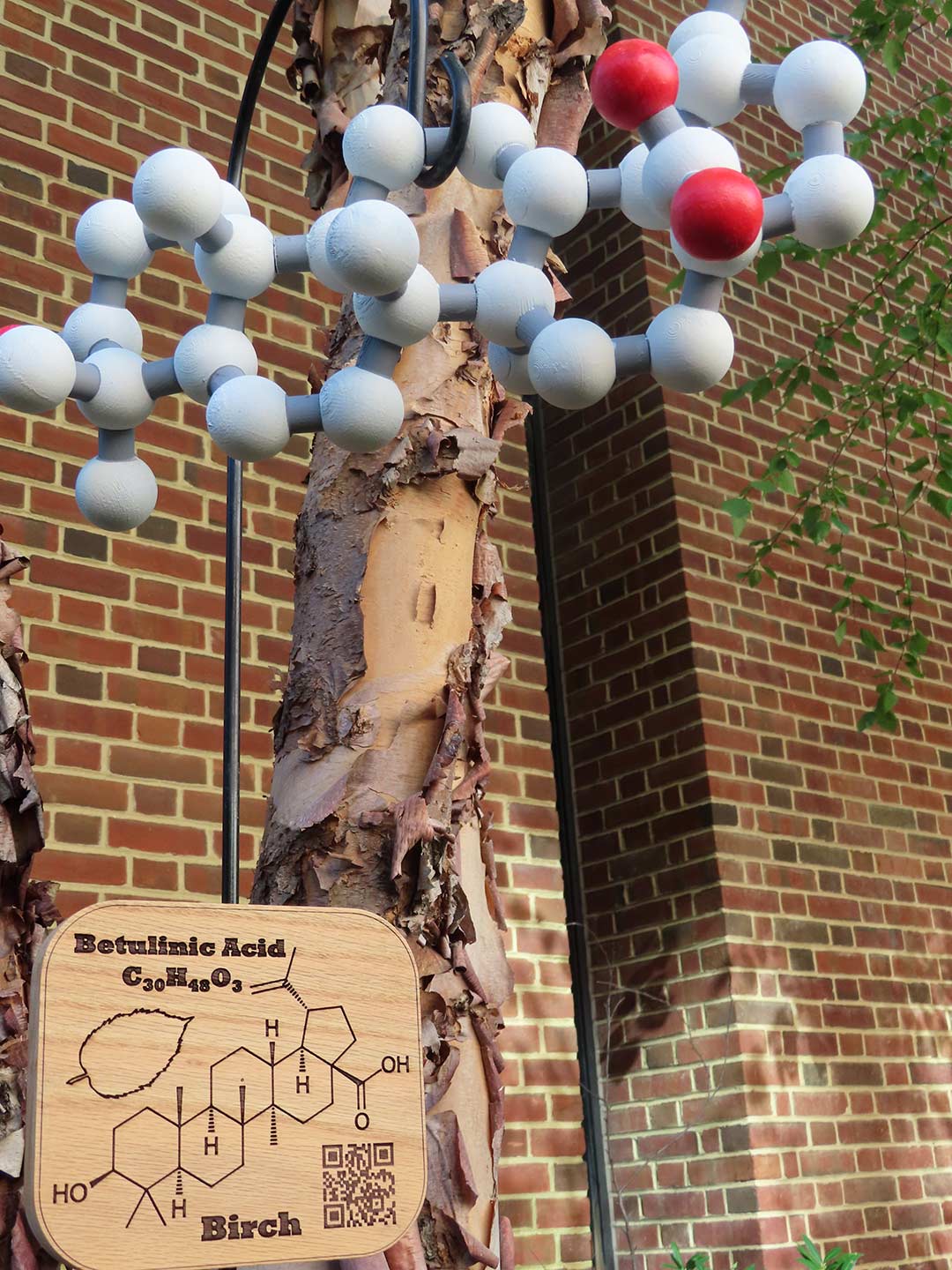- February 02, 2021
- By Kimbra Cutlip
Where most of us probably register only generic trees on a walk across campus, Jeffery Davis might see a river birch, reminding him of the tumor-inhibiting betulinic acid it produces; the decorative purple clusters of an American beautyberry, meanwhile, call to mind the natural mosquito repellent in its leaves.
As an organic chemist who specializes in synthesizing compounds, Davis wants to inspire the rest of us to notice the chemistry that’s all around, especially in nature. That’s why the professor of chemistry and biochemistry and two colleagues are turning the Chemistry Building’s courtyard garden into a walking introduction to the molecular world of plants. Their vision is a living classroom where 3D models of chemical compounds accompany the real-life plants that produce them, along with signs and links to online information about their medicinal or nutritional uses.
 “Nature is a chemistry synthesis lab right under our noses,” Davis said. “And when you get down to the molecular level, much of our natural world can be understood with chemistry.”
“Nature is a chemistry synthesis lab right under our noses,” Davis said. “And when you get down to the molecular level, much of our natural world can be understood with chemistry.”
The project is a collaboration between Davis, Associate Professor of Chemistry and Biochemistry Paul Paukstelis and Adjunct Assistant Professor of Plant Science and Landscape Architecture Andrea Ottesen. Davis got the idea when he was preparing to teach “Organic Synthesis” to graduate students in Spring 2020. He had just returned from Peru, where he assisted Ottesen in teaching a study-abroad class called “Medicinal Plants of the Amazon.”
“For the first time, I had a really awesome chemist on the trip,” said Ottesen, who is also the research area coordinator for metagenomics at the U.S. Food and Drug Administration’s Center for Food Safety and Applied Nutrition as well as a professional artist. “In the past, it’s been mostly botanists and ethnobotanists, and while we talk about chemical compounds in plants and what they do, we’ve never had anyone with us who really knew what that meant at a deeper, mechanistic level.”
Davis found that the trip reinvigorated his appreciation for the relationship between people and the natural world.
With the experience fresh in his mind, he took a different approach to his organic chemistry class. Instead of having students memorize name reactions and reagents, Davis wanted them to understand how chemical compounds are isolated directly from the environment. So he and Ottesen took the class on a tour of campus, pointing out plants and highlighting the various properties of their many natural products—dyes, medicinal ingredients and more.
Then, each of the seven students in the course identified two such products from plants growing in the Chemistry Building’s courtyard garden, and Davis designed the course’s syllabus around studying both the biosyntheses and organic syntheses of the 14 substances..
Chemistry graduate student Solomon Kojo Attionu said making the connection between the chemical formulas and the real world made the course material easier to understand and remember.
“Having an interactive class for organic is very helpful, and being able to see how things at a microscopic level eventually manifest themselves in the physical world all around us is quite amazing,” Attionu said.
Just as Davis had hoped, the class also inspired some students to see the world from a new, chemistry-informed perspective. “I noticed that the sweetgum fruits were similar in shape to coronaviruses,” said Mona Abdelrahman, “and I was astonished to learn that the tree contains shikimic acid”—a precursor to an active ingredient in the antiviral Tamiflu.
When they designed the course, the team planned for students to work with Paukstelis in the department’s 3D-printing lab to create molecular sculptures of the compounds they studied, but that part of the project was delayed by the campus lockdown last year, along with Paukstelis diverting much of his printing efforts to making personal protective equipment for hospitals’ staff.
But Paukstelis has since printed seven of the students’ compounds and created a pair of wooden sign for one of the plants with the molecular formula and a QR code that links to the website the students created.
The team is still working out the details on how to display the 3D sculptures and signs permanently in the garden once they are all completed. Soon, Davis and his collaborators will have characterized 20 plants in the garden, and they are envisioning the next steps for the project.
Determined to share the work broadly and generate enthusiasm far beyond their classes, they are putting the 3D models online for anyone to download and print on their own.
“It’s not just chemistry in our garden,” Paukstelis said. “It can be chemistry in your garden, too.”
